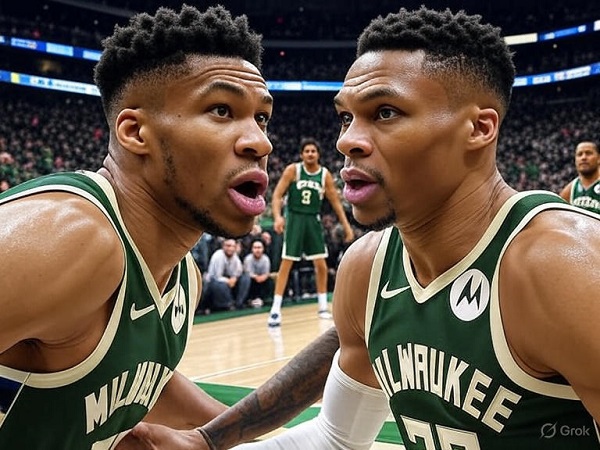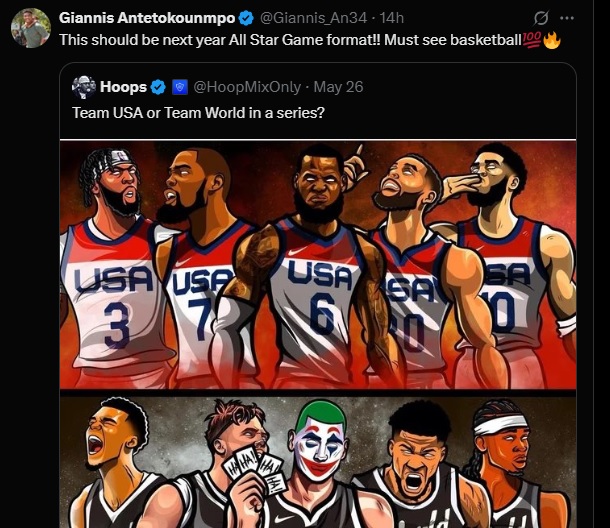With Russell Westbrook still sitting on the free-agent market after declining his player option with the Denver Nuggets, ESPN’s Kendrick Perkins floated the idea that Milwaukee should swoop in and sign the 37-year-old veteran. On paper, it sounds intriguing: a win-now team desperate for backcourt stability after cutting ties with Damian Lillard, pairing Westbrook’s explosive energy with Giannis Antetokounmpo’s dominance. But let’s pump the brakes. This isn’t just a questionable fit—it’s a recipe for regression that could derail the Bucks’ championship aspirations. It’s uglier than a mid-range brick in overtime.
Westbrook’s Game in 2025: A Triple-Double Machine That’s Triple the Headache
Westbrook’s résumé is legendary—NBA MVP, nine-time All-Star, all-time leader in triple-doubles. But at 37, his game has devolved into a highlight-reel sideshow with diminishing returns. In his final season with Denver (2024-25), he posted 13.3 points, 6.1 assists, and 4.9 rebounds across 75 games—solid bench numbers, sure. He still brings that manic energy, pushing the pace and crashing the glass like it’s 2017.
The cracks, however, are canyon-sized. His field-goal percentage hovered around 44.9%, and his three-point shooting? A woeful 31.4% on low volume (just 2.1 attempts per game). That’s not “broken jumper” territory; that’s “defences dare you to shoot” territory. Add in his league-leading turnover rate among high-minute guards (3.2 per 36 minutes) and a defensive rating that drags units underwater, and you’ve got a player whose plus/minus has been negative for five straight seasons.
Westbrook’s style—ball-dominant, paint-attacking, reluctant passer in crunch time—worked in limited roles with the Clippers and Nuggets, where he came off the bench. But starting him? That’s where the wheels fall off. He logged a usage rate north of 25% last year, jacking up contested twos and forcing the issue when smarter reads were available. For a Bucks team already questioning its backcourt rhythm, injecting Westbrook’s chaos would amplify the noise, not harmonize it.
The Nightmare Fit: How Westbrook Would Break the Bucks’ Offence and Defence
Let’s game this out. Imagine Porter Jr. (or whoever starts) sharing the floor with Westbrook in a two-PG lineup. Both are undersized (Porter at 6’4″, Westbrook at 6’3″), both love to handle, and neither shoots well enough from deep to punish switches. Result? A backcourt traffic jam that funnels everything into the mid-range—precisely what killed Milwaukee’s spacing last year. Giannis would feast on lobs and cuts, but Portis’ spot-up game gets neutralized, and others off-ball movement turns into a crawl.
Offensively, Westbrook’s inefficiency would compound the Bucks’ issues. His true shooting percentage sat at 50.2% last season—below league average for guards—and he’d be chucking in high-leverage spots. Defensively? Forget it. Westbrook’s lateral quickness has eroded with age; opponents targeted him relentlessly in Denver, leading to a -4.1 net rating in his minutes. Pair that with Porter’s own defensive lapses, and Milwaukee’s perimeter D—already middling—becomes a sieve. The Eastern Conference is loaded with sharpshooters like Jalen Brunson, Tyrese Haliburton, and Trae Young; Westbrook’s gambling for steals would leave Giannis in iso hell on the other end.
Even in a bench role, it’s a mismatch. The Bucks need a microwave scorer or a true combo guard to spell Porter, not a volume creator who hogs touches from a second unit featuring Portis and Trent. As Brew Hoop astutely noted, “Milwaukee would be wise to pass” because Westbrook’s skill set doesn’t align with Doc Rivers’ preference for structured, ball-movement offenses. Rivers thrived with balanced units in Boston and Philly; Westbrook’s heliocentric approach would feel like a step backward.
The Greek Freak has chinks in his armour—flaws that have been dissected ad nauseam, from his inconsistent free-throw shooting (hovering around 71% career, with dips in high-pressure moments) to his limited outside game (a career 28.9% from three, forcing defences to pack the paint). Add in occasional half-court stagnation, where his ball-handling can lead to turnovers if lanes aren’t open, and play making lapses under duress, and you’ve got vulnerabilities that savvy teams exploit in the playoffs. Now, imagine pairing him with Russell Westbrook, a guard whose declining skill set would turn these weaknesses into glaring liabilities, potentially derailing Milwaukee’s offence and exhausting their star.
At the core of the mismatch is spacing—or the lack thereof. Giannis thrives when the floor is stretched, allowing him to euro-step through open driving lanes without meeting a wall of defenders. Westbrook, however, is a non-shooter from deep, converting just 31.4% on minimal attempts last season, which invites opponents to sag off him and dare the brick. This defensive strategy would clog the paint even more than usual, forcing Giannis into contested drives or pull-up jumpers—shots he’s notoriously inefficient at. We’ve seen this movie before: In the 2025 playoffs, without Damian Lillard’s gravity pulling defenders out, Giannis’ efficiency dipped in half-court sets, with turnovers spiking as he tried to force plays. Westbrook’s presence would exacerbate this, turning Giannis’ drives into a mosh pit and highlighting his reluctance (or inability) to punish from outside. Defenses could essentially play 5-on-4 in the lane, neutralizing Giannis’ greatest strength and pushing him toward more free throws—where his mental blocks and mechanical issues often rear their head, as evidenced by his sub-60% FT% in key 2025 EuroBasket games.
Defensively, the ripple effects would be just as damaging. Westbrook’s eroded lateral quickness and gambling tendencies have made him a target for opponents, often resulting in blow-bys and open looks that require help-side rotations. Giannis, already Milwaukee’s defensive anchor as a roaming rim protector, would be forced to cover more ground, cleaning up Westbrook’s messes while expending extra energy. This added workload could accelerate fatigue for the 30-year-old superstar, who’s shown signs of wear in recent seasons, and amplify his occasional lapses in perimeter containment—another subtle weakness when he’s stretched thin. Moreover, Westbrook’s ball-dominant style and high turnover rate (3.2 per 36 minutes) would disrupt rhythm, potentially reducing Giannis’ touches in favourable spots and forcing him into more isolation creation, where his playmaking vision isn’t elite. In a post-Lillard Bucks backcourt already lacking facilitators, this chaos would spotlight Giannis’ half-court limitations, turning him from a dominant force into a frustrated one-man army.
Chemistry Red Flags: Leadership Lessons from Westbrook’s Past
Beyond the tape, there’s the intangibles. Westbrook is a warrior—fiercely competitive and vocal—but his intensity has rubbed teammates the wrong way. Remember his Lakers tenure? What started as a “Big Three” experiment devolved into finger-pointing and a first-round exit. Perkins himself admitted to warning Westbrook about his “cancerous” behaviour back then, a comment that ended their friendship. In Denver, he was a positive vet, but that was as a reserve. Thrust him into a starting role on a pressure-cooker team like Milwaukee, and the alpha clashes could erupt—especially with a young, unproven Porter Jr. needing guidance, not competition.
The Bucks can’t afford distractions. With a win-now core entering its mid-30s window, they need cohesion, not controversy.
Steer Clear, Milwaukee
Russell Westbrook deserves a ring and a graceful fade-out on a contender’s bench. But the Bucks? They’re not that team—not with their spacing starvation, defensive vulnerabilities, and need for harmony. Pairing him with this roster wouldn’t unlock potential; it’d expose flaws. As Reddit’s NBA hive mind put it, Westbrook’s playstyle “only works on one team in the league,” and Milwaukee ain’t it. Doc Rivers and Jon Horst have built a contender; don’t let nostalgia torch it.

